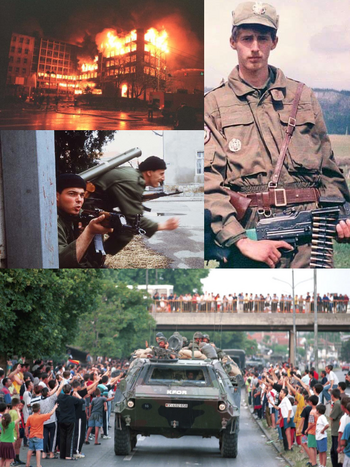Hytekojuznik Civil War
This article is incomplete because it is pending further input from participants, or it is a work-in-progress by one author. Please comment on this article's talk page to share your input, comments and questions. Note: To contribute to this article, you may need to seek help from the author(s) of this page. |
| Hytekojuznik Civil War | |||
|---|---|---|---|
| Part of the Fall of Communism in Aeia | |||
 Clockwise from top-left: A Juznik hospital on fire in Laukapė after Hytek bombings, a Hytek soldier holding an AK-74, a Juznik tank during a parade after Purvėnai is retaken, Hytek urban militia fighters during the Battle of North Uznava | |||
| Date | January 28, 1986 – October 31, 1989 (3 years, 9 months, 3 days) | ||
| Location | |||
| Caused by | Oppression of Juzniks by majority Hytek government Fall of communism | ||
| Goals | Juznik independence | ||
| Resulted in | Juznik victory
| ||
| Parties to the civil conflict | |||
| Lead figures | |||
| Number | |||
| |||
| Casualties | |||
| |||
| Total casualties: 547,756–667,600 Total displaced: c. 1,100,000 | |||
The Hytekojuznik Civil War, also referred to as the War of Independence or War of Liberation in Juznia was a civil war and war of independence fought mainly along the border of Hytekia and Juznia from Juznia's unilateral declaration of independence in January 1986 to the signing of the Višnevas Accords at the end of October 1989. The war is one of the largest civil conflicts in Aeian history, involving over 1.5 million military personnel (including volunteer divisions from supporting countries) at its peak in 1989, and saw the displacement of over a million civilians as well as the destruction of many important Hytek and Juznik buildings throughout its duration.
The majority of Juzniks living in Juznia wanted the country to secede from the People's State of Hytekojuznia and become independent, while Hyteks in Juznia, supported by much of the communist world, advocated for the country to remain part of the union to share a common land with all Hytek peoples. With anti-Juznik sentiment growing ever since the sacrifice of many Juznik soldiers, disputably willingly by the Hytekojuznik government, at the Siege of Anlaufhafen, and the fall of communism affecting and weakening many communist regimes across Asura, Juznia declared independence on January 26, 1986 with the support of the majority of ethnic Juzniks as well as some staunch anti-communist Asuran nations, such as Cuirpthe and Liiduria. Chairman of the Hytekojuznik Communist Party and de facto leader of Hytekojuznia Aivars Muceniece issued an ultimatum to Juznia on the same day, instructing them to rejoin the country or face invasion. When Juznia rejected the ultimatum two days later, Hytekia issued a declaration of war and invaded with the support of communist Veleaz.
Initially, Hytekia aimed to secure a quick occupation of most of southern Juznia to effectively force them into signing peace and rejoining the People's State, with two quick spearhead offenses beginning on both sides of the country. The first two offenses by Hytekia displayed the ineffectiveness of both the Hytek and Juznik militaries after decades of relying on the FSR for military protection. The two countries' small militaries quickly dwindled and the war almost immediately became one dominated by independent militias. The Battle of North Uznevas in November 1986 showcased the first large-scale militia fighting of the war, with around 50,000 total fighters present within the boundaries of the city during the battle. It was in Uznevas when the first iterations of the Nāvečuksti (lit. "death whisperers") began their civilian killings, with the Uznevas Massacre occurring throughout November, resulting in at least 1,500 civilian deaths.
Juznia launched their first major offensive into Hytekia with the support of Cuirpthean volunteer divisons during Operation Horseback in 1987, successfully taking the city of Grobina, which would switch hands at the end of the war. The JLA often recruited ethnic Juzniks to their cause in the Hytek border cities, arming them with weapons seized from Hytek towns, but more often employing them as carriers or messengers. After Horseback, Hytekia retaliated with a counter-offensive just east of Grobina in the April of 1987, the first offensive to utilise aerial warfare in the conflict. The Laukapė bombings were carried out during this counter-offensive, in which over 3,000 were killed, including many children after a hospital was bombed near the city's centre, much to the condemnation of the international community. The war crimes of Hytekia during the war would ultimately ramp up support in other belligerent nations for war in support of Juznia and the Juznik people.